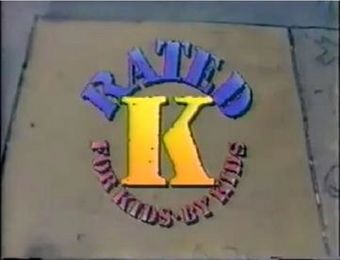Rated K: For Kids by Kids facts for kids
Quick facts for kids Rated K: For Kids by Kids |
|
|---|---|
 |
|
| Genre | Film review |
| Created by | Debby Beece |
| Developed by | Andy Bamberger |
| Presented by |
|
| Theme music composer | Peter and Jennifer Fish |
| Composer(s) |
|
| Country of origin | United States |
| Original language(s) | English |
| Production | |
| Executive producer(s) | Geoffrey Darby |
| Producer(s) |
|
| Production location(s) | New York City |
| Editor(s) |
|
| Camera setup | Multi-camera |
| Running time | 26 |
| Distributor | MTV Networks |
| Release | |
| Original network | Nickelodeon |
| Picture format | NTSC (480i) |
| First shown in | United States |
| Original release | November 1, 1986 – December 18, 1988 |
Rated K: For Kids by Kids was a TV show on Nickelodeon from 1986 to 1988. It was all about kids reviewing movies! Young hosts would watch the newest films and share their honest thoughts. Sometimes, they even talked about new home video releases.
The show used a special grading system for movies. For example, 'A' meant 'Amazing,' 'C' could mean 'Classic,' 'Confusing,' or 'Crazy.' 'G' meant 'Go,' 'S' meant 'See It' or 'So-So,' and 'T' meant 'Terrific.' The best grade a movie could get was 'Letter K,' which was like a perfect score!
How the Show Worked
The three hosts would sit on a pink couch with white stars, around a small blue table. The parts where they introduced the movies were written down. But when they gave their opinions, it was all improvised (made up on the spot). This often led to fun, playful teasing among the hosts.
Since the show was on Nickelodeon and aimed at young people, it rarely reviewed movies with an "R" rating. These movies are usually for adults. If an R-rated movie was reviewed, it was because it was important to young viewers. An example is the 1986 film Stand by Me. This movie was about four young boys on an adventure.
Sometimes, if there weren't enough new kid-friendly movies, the hosts would talk about older films. They might even discuss movies already out on VHS. One episode featured a segment about the films of famous director Alfred Hitchcock. Another time, the hosts interviewed well-known movie critics Roger Ebert and Gene Siskel.
The Big Ballot: Kids' Favorite Picks
Starting in March 1987, Rated K presented something special called "The Big Ballot." This was a nationwide poll where kids voted for their favorite movies, TV shows, music, and sports from the past year. Kids sent in their votes by mail.
The winners would record a thank-you video, which was shown during the program. The Rated K hosts would introduce these videos. The Big Ballot was sponsored by Bonkers fruit chews and Post Cereal.
A year later, Nickelodeon took the idea of The Big Ballot and turned it into the Kids' Choice Awards. The Kids' Choice Awards became a live TV event. For The Big Ballot, winners received a golden teleidoscope trophy. Later, at the Kids' Choice Awards, winners started getting the famous Orange Blimp Award.
Nickelodeon doesn't officially call The Big Ballot the first Kids' Choice Awards. The Big Ballot happened over four weeks in 1987. During this time, Rated K: For Kids by Kids still reviewed movies, like Blind Date, before showing segments about The Big Ballot.
Changes in Later Episodes
In 1988, Rated K became even more important to Nickelodeon. Other shows like Livewire and Standby...Lights! Camera! Action! had ended. This meant Rated K was the only show left that covered different types of media. So, Nickelodeon decided to make big changes to the show's look and focus.
The original hosts, Matt Nespole, Lakmini Besbroda, Mark Shanahan, and Rebecca Schwager, were getting older. They were replaced by new hosts like Stefanie Marco, Jeremy Ryan, Kirk Gibbons, Robyn Griggs, Joel Savani, Alek Lev, and Brad Kane.
Each new host had a special role. For example, only Robyn Griggs and Joel Savani reviewed movies. Brad Kane hosted the Rated K Update. These short segments aired during commercial breaks. Brad Kane interviewed famous young people and talked about fun topics in entertainment and even politics. He interviewed stars like Alyssa Milano and Carrie Fisher.
The show's set was also changed to look like a movie concession stand. It used soft, pastel colors. The new Rated K was more scripted and polished than the earlier, more improvised episodes.
Besides movie reviews, Rated K started doing more behind-the-scenes features. It also began to cover other kids' media, like video games and theme park attractions. Celebrities like Wil Wheaton even reported from places like Universal Studios Hollywood. He talked about the Star Trek Adventure attraction there.
The new version of Rated K: For Kids by Kids was more like a TV news magazine show, similar to Entertainment Tonight. This updated version of Rated K aired until its final episode on December 18, 1988.

